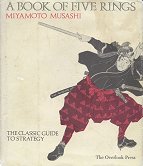This is a famous book in Japanese philosophy, written in 1645, about The Way of the Sword, but used as a general guide to living by its followers. Here it is translated by Victor Harris.
I suspect the reason why it means so much to so many people is that it doesn't actually say anything very specific, so you can read into it nearly anything you like. A little of the advice is clear, and sensible, like:
But a lot of it is more like the "explanation" of the attitude "to stab at the face":
To which my response is simply, WTF? In fact, the woo is strong with this one, with things like:
Nearly every short paragraph has an exhortation like: "You must appreciate this", or "You must learn this", or "You must research this well". But there isn't much "this" given to appreciate, learn, or research. Maybe it helps if you are a swordsman. But that makes it sound like "you can understand this if you already understand this from a different source." Or it may just be a poor translation: the style of the translated text is similar to the style of the historical preface. But I suspect not.
